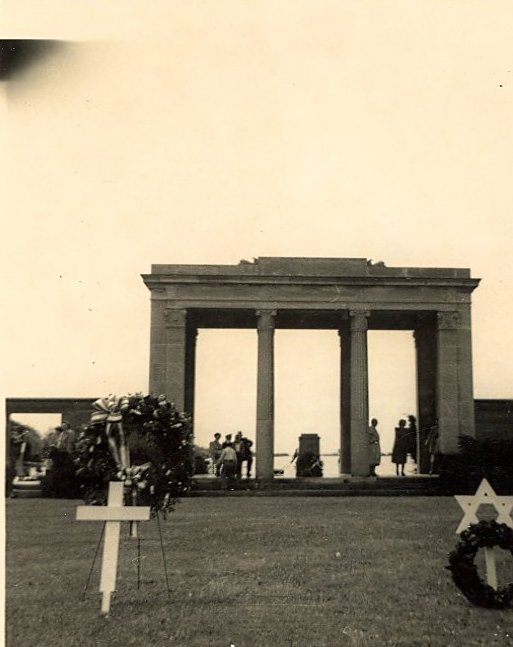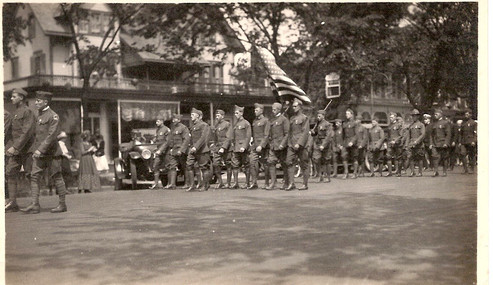I recently found a bundle of brittle letters in my parent’s attic. They turned out to be letters written home to family members by my two uncles who were both fighting in France during WW l. Frank Laurence Raynor (age 28) and Wilmun Halsey Raynor (age 25) were two of my grandmother’s four brothers.
Frank and Amy Raynor and their seven children had hit hard times when Laurence and Wilmun were enlisted. The family was living on the first floor of the Maddock house on North Main Street in Southampton Village. Amy flew a large American flag on the roof for the soldiers to see as they passed through town on the train. Uncle Laurence was the first to leave in Sept. 1917. Uncle Wilmun (Flip) followed in April 1918. When they left home it was the last time they saw their mother. She died in 1918 at the age of 54.
This letter is of particular interest because it was written six days after Armistice Day, (11:00 am on November 11, 1918), the day the guns fell silent on the western front.
Private 1st class Laurence Raynor
Camouflage Section American E.F.
Sunday 3:30 PM Nov. 17, 1918
Dear Father:
I am still here in the same camp. And we are getting things together. So we can leave soon. All the French people are happy to see the war over. And I guess everybody over in the states is just as happy. There is a bunch of Englishmen coming in. They were prisoners in Germany. Some of them are in poor condition. And they say the Germans didn’t treat them well. And they had very little to eat. They are all very thin. They have old clothes that makes them look worse. But they are all happy and can hardly believe the war is over. They were all taken from the prisons and turned loose. So they walk from the German front to the French cities. I don’t think we will be over here many more months. But I don’t suppose we will get back before spring. France is not a bad place to live and if I had a good business here I would just as soon stay here. It begins to get colder all the time. But we haven’t had any snow yet. It is nice to see the streets all lit up. And not have to think of Fritz coming over. This afternoon I went for a walk around in the city. I have not seen Flip over here. I hope he is all right. I have a friend here yet. And we go out together every day. I am going up to the Y.M. and perhaps they will have some moving pictures on. It is beginning to feel like home to me in this city. I haven’t had any mail for some time. But I guess I will get some next week. The grapes are nearly all gone. And apples are all high priced. I am going up to get a paper now. There is not much news for me to write. I hope you are all well. And I hope I shall be able to see you all again soon. So good bye with love to you all. I am your loving son Laurence.
The letter does not mention the city where Laurence was. He mentions his brother Flip (Wilmun) and had no way of knowing that Flip had been severely gassed on Oct. 16, 1918 and was in a hospital in France. Laurence returned home in 1919. He married and remained in Southampton.

Flip wrote to his older brother Lester from a hospital in southern France. He also writes of the Armistice.
Private Wilmun Raynor
Co. H, 101st Infantry
Nov. 28, 1918
Dear Lester,
Thanksgiving Day and have just received two letters from you one from Edith and one from Helen Fitz and Amy Jones. So you see I did not do so bad did I.
So you all had quite some time when you all heard of the news. Well Les I was at the 12th Gen hospital at Rouen and Rouen is the third largest city in France gee that town sure did go mad Les. I had a very good time anyway.
As for the gas I got, why I was burned more than anything. I did get quite some bad burns but they are nearly all well now so I am a lucky boy you see. I had quite some time with my eyes to. The gas I got was mustard gas.
We hear we are going to leave for the U.S.A. before long and I am ready any time to leave here. I am now in southern France and it is nice country here and like it very much.
Well Les I am going to say good bye this time. I am as ever Your Loving Brother Flip. Love to all.
Flip returned home in 1919. He moved to Missouri, married and had one son. Sadly he died in 1952 at the age of 58 from the effects of the injuries to his lungs in France.
World War l lasted from 1914 – 1918. Woodrow Wilson was the president during that time. The true cause of WW l was the tension that was rising among the rival imperial powers of Europe. The assassination of the Archduke Francis Ferdinand (heir to the throne of the Austro-Hungarian Empire) and his wife Sophia was a catalyst that provoked the war, June 28, 1914.
The war involved over 30 countries. The U.S.A. tried to remain neutral while shipping supplies to England. The Germans were sinking our supply ships, (unrestricted submarine warfare). The U.S.A. joined the war in 1917 after the sinking of the Lusitania with 124 Americans on board. The allies which included the US fought against the central powers. Austria-Hungry, Bulgaria, Germany, and The Ottoman Empire. The Americans only fought in France. Gen. John J. Pershing was the commanding general of all American forces in Europe. American soldiers were referred to as “Doughboys”. Nobody seems to know why.
11 November, 1918 at 11:00 am, the Armistice (cease fire) was signed at Le Francport near Compiègne, France.
28 June, 1919, The Treaty of Versailles ended the war.
On August 19, 1923 the World War I Monument in Agawam Park was dedicated. The following is a list of the soldiers from Southampton Village who died during the war along with their ranks and where they died.
Leland Clancy, private, Company B, 303d Field Sig. Bat., August 19, 1918, France.
Sheldon E. Hoadley, first lieutenant, Bat. D. 350th F. Art., 77th Div., Oct. 13, 1918, France.
Glen Kelso, private, Headquarters Company, 107th Infantry, 77th Div., Oct. 13. 1918, France.
Joseph F. Stillman, jr., Cadet, Aviation Section, Signal Corps, Feb. 23, 1918, England.
Isaac Tisnower, corporal. Company B. 398th Infantry, 77th Div., Sept 14, 1918, France.
Malcolm R. White, private, Bat. A. 7th F. Art., 1st Div., May 18, 1918, France.
Julius Zologia, private, Company C, 313th Infantry, Nov. 11, 1918, France.
Images of the Monument in Agawam Park
Images of WWI soldiers in Southampton
If you’d like to learn more about the history of WW l, I recommend, “America and the Great War”, An overview history of WW l by local author Philip A. Keith.
.png)





















